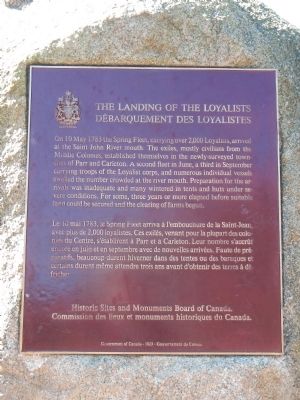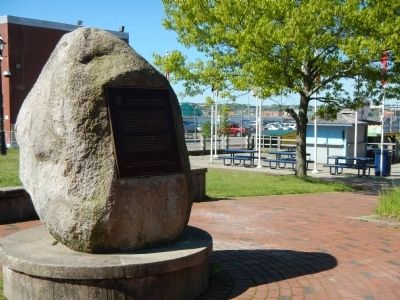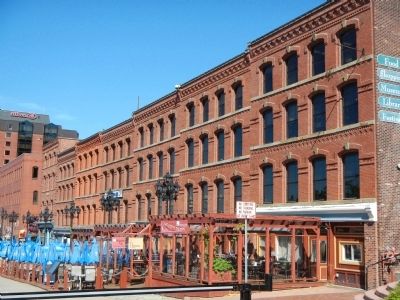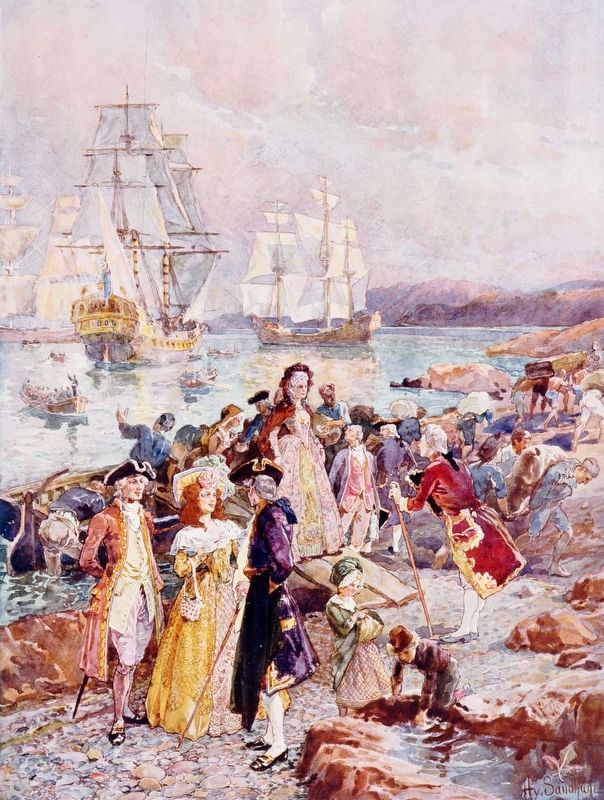Saint John in Saint John County, New Brunswick — The Atlantic Provinces (North America)
The Landing of the Loyalists
Débarquement des Loyalistes
On 10 May 1783 the Spring Fleet, carrying over 2,000 Loyalists, arrived at the Saint John River mouth. The exiles, mostly civilians from the Middle Colonies, established themselves in the newly-surveyed townsites of Parr and Carleton. A second fleet in June, a third in September carrying troops of the Loyalist corps, and numerous individual vessels swelled the number crowded at the river mouth. Preparations for the arrivals was inadequate and many wintered in tents and huts under severe conditions. For some, three years or more elapsed before suitable land could be secured and the clearing of farms begun.
French
Le 10 mai 1783, le Spring Fleet arriva à l’embouchure de la Saint-Jean avec plus de 2,000 loyalistes. Ces exilés, venant pour la plupart de colonies du Centre, s’établirent à Parr et à Carlton, Leur nombre s’accrût encore en juin et en septembre avec de nouvelles arrivées. Faute de préparatifs, beaucoup durent hiverner dans des tentes ou des baraques et certains durent même attendre trois ans avant d’obtenir des terres à défricher.
Erected 1923 by Historic Sites and Monument Board of Canada/Commission de lieux et monuments historique du Canada.
Topics and series. This historical marker is listed in these topic lists: Settlements & Settlers • War, US Revolutionary. In addition, it is included in the Canada, Historic Sites and Monuments Board series list. A significant historical date for this entry is May 10, 1783.
Location. 45° 16.358′ N, 66° 3.815′ W. Marker is in Saint John, New Brunswick, in Saint John County. Marker can be reached from the intersection of Market Square and Water Street, on the right when traveling east. Touch for map. Marker is at or near this postal address: 1 Market Square, Saint John NB E2L 0A1, Canada. Touch for directions.
Other nearby markers. At least 8 other markers are within walking distance of this marker. Oland Family Breweries (within shouting distance of this marker); Scottish Strength (within shouting distance of this marker); The Marco Polo (within shouting distance of this marker); A Legacy of Tea | Du thé en héritage (about 90 meters away, measured in a direct line); Prince William Street - Before and After the 1877 Fire (about 90 meters away); Centerbeam Place (about 120 meters away); Saint John 225th Anniversary Clock (about 120 meters away); First Steam Fog Horn (about 120 meters away). Touch for a list and map of all markers in Saint John.
Also see . . .
1. May 18, 1783: United Empire Loyalists reach Canada - History Channel. Most of the refugees came from New York, which had been under royal control throughout most of the War for Independence. After the Treaty of Paris ended the War for Independence in February 1783, the British evacuated their New York Loyalists to remaining British territories, mainly in Canada. These families had been dispossessed of their land and belongings by the victorious Patriots because of their continued support of the British king and were able to regain some financial independence through lands granted to them by the British in western Quebec (now Ontario) and Nova Scotia. (Submitted on September 24, 2014, by Barry Swackhamer of Brentwood, California.)
2. What Happened To British Loyalists After The American Revolutionary War?. 3½ minute 2015 National Public Radio All Things Considered interview. Rachel Martin interviews Maya Jasanoff, professor of history at Harvard University. “About half of the loyalists who left the United States ended up going north to Canada, settling in the province of Nova Scotia and also becoming pioneering settlers in the province of New Brunswick.” (Submitted on May 5, 2018.)
Credits. This page was last revised on May 5, 2018. It was originally submitted on September 24, 2014, by Barry Swackhamer of Brentwood, California. This page has been viewed 975 times since then and 78 times this year. It was the Marker of the Week May 6, 2018. Photos: 1, 2, 3. submitted on September 24, 2014, by Barry Swackhamer of Brentwood, California. 4. submitted on May 5, 2018, by J. J. Prats of Powell, Ohio. • Andrew Ruppenstein was the editor who published this page.



